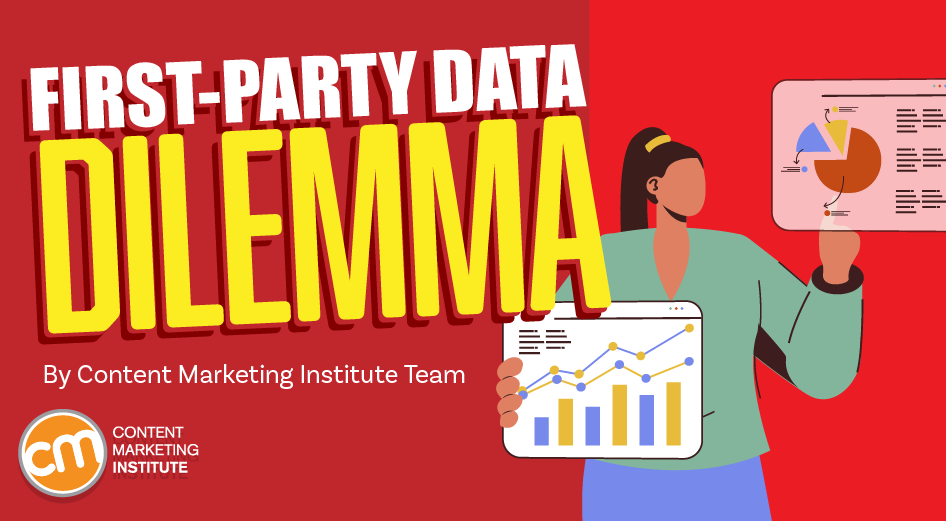You know that scene from Seinfeld where Jerry challenges a customer representative who tells him they have no rental cars available even though he had a reservation?
“I know why we have reservations,” the car rental worker replies after Jerry expresses his dismay.
“I don’t think you do. If you did, I would have a car. See you know how to take reservation, you just don’t know how to hold the reservation. And that’s really the most important part of the reservation – the holding,” Jerry replies.
As it turns out, marketing takes a similar approach to first-party data acquisition. New Gartner research says it’s not about policies to guide how you take the first-party data; it’s about the experiences to capture the first-party data. It’s the experience – the exchange of value – that’s the most important part.
Get Robert Rose’s take in this week’s CMI News video or keep reading for the highlights:
Striking the data balance between privacy and customer value
The headline for the report release read, “Gartner Survey Finds 60% of Marketing Leaders Believe Collecting Customer Data While Balancing Privacy and Customer Value Will Be More Challenging in 2023.”
(While that’s the story they discuss, CMI chief strategy advisor Robert Rose says he thinks the more interesting story would be the 40% who don’t think data collection will be more difficult this year.)
Of the marketers Gartner surveyed at the end of last year, 85% have implemented a formal policy to manage customer data. Further, 42% of respondents are actively executing one-to-one personalized messages to customers. And 82% say using first-party data to create immediate value for customers is a priority. But privacy remains an ongoing challenge.
Robert finds another stat interesting – 78% of marketers empower their customers to manage their own data. If they really let the customers do it, that isn’t a bad choice. But, he says, was that choice a marketing decision? Or was it made by account service leaders?
In other words, he asks, do you think 78% of marketers allow prospective customers or pre-purchase audiences to manage their own data? Robert doesn’t think so, noting that even Gartner doesn’t allow him to manage how they use his email address for sending news about Gartner’s awesomeness.
78% of marketers say their brand lets customers manage their own data. But what about pre-purchase audiences, asks @Robert_Rose via @CMIContent. #ContentMarketing Click To TweetMore or less for your data optimization strategy?
One lesser-promoted finding is worth a closer look. Gartner suggests that decreasing the number of channels acquiring first-party data is not an optimal strategy.
Almost half of the organizations managing 11 or more marketing channels increased their first-party data collection compared with just over a quarter of those with 10 or fewer channels. Companies with more channels are also more likely to drive growth through new digital content experiences.
This finding may not make the headlines, but it should open some eyes. Marketers who create niche digital experiences for target audiences based on where they are in their journey – and capture only the data needed at that stage – get a bigger bang for their investment.
You don’t need to capture the name, title, and buying power statistics for someone who reads your blog’s thought leadership. You just want to know their intent – why did they access the article and what did they find valuable about it? That gives you all the first-party data needed to serve up the best experience that readers might want next.
Marketers who capture only the data they need from the audience get a bigger bang for their investment, says @Robert_Rose via @CMIContent. #ContentMarketing Click To TweetThis scenario assumes your digital experiences connect to build first-party data attributes over time. You can infuse great, valuable content into every digital experience and only ask for the data when you need it.
And that’s the key. Yes, designing a privacy policy, understanding its rules, and knowing how you make data accessible is important. But designing and managing the acquisition of that data – through content experiences – should act as the most important part of your first-party data acquisition strategy. It’s not a challenge for legal. It’s not a challenge for IT. It’s the challenge for content and marketing.
At the end of the Gartner research, a senior analyst warns, “Data privacy is an issue that isn’t going away, and it’s imperative that digital marketing leaders build strategies that will secure the data they need while keeping the needs of customers front and center.”
Robert turns that thinking slightly on its head: “Stricter notions of privacy become less of an issue when you deliver better-designed content that prioritizes the needs of the customer vs. your need to capture all the data at one time. You build in a more obvious exchange of value.
“If a customer understands why they give their data and believe it’s worth it, then they worry much less about how you might use it.”
In other words, if you consistently hold the reservations, the customer will worry less about trusting your brand when you take the reservation.
Cover image by Joseph Kalinowski/Content Marketing Institute

